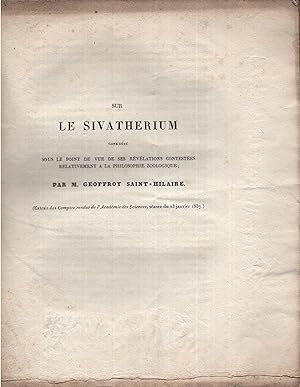Philosophie Zoologique, First Edition (5 results)
Product Type
- All Product Types
- Books (5)
- Magazines & Periodicals
- Comics
- Sheet Music
- Art, Prints & Posters
- Photographs
- Maps
-
Manuscripts &
Paper Collectibles
Condition
- All Conditions
- New
- Used
Binding
Collectible Attributes
- First Edition
- Signed
- Dust Jacket
- Seller-Supplied Images (3)
- Not Printed On Demand
Free Shipping
Seller Location
Seller Rating
-
La philosophie zoologique avant Darwin.
Published by Paris: Ancienne Librairie Germer Baillière, Félix Alcan, editeur, 1884., 1884
Seller: Scientia Books, ABAA ILAB, Arlington, MA, U.S.A.
First Edition
Hardcover. Condition: Good. 1st Edition. xii, 292 pp; ads. Original cloth. Foxed. Top & bottom of spine worn and sunned. Nick in rear joint. First Edition.
-
Sur le Sivatherium considéré sous le point de vue de ses révélations contestées relativement à la philosophie zoologique,
Published by [Paris, Bachelier]., 1837
Seller: PRISCA, Paris, France
First Edition
Couverture souple. Condition: Très bon. Edition originale. In-4 de 12 pages avec une planche des fossiles de Himalaya; exemplaire broché sous couvertures muettes de l'époque. Rare tiré-à-part des Comptes-rendus des séances de l'Académie des Sciences, séance du 23 janvier 1837.
-
Filosofiya zoologii. [Philosophie zoologique]. Translated by S. V. Sapozhnikova.
Seller: Antiquariaat Schierenberg, Amsterdam, Netherlands
First Edition
Moscow, 1933-1937. In two volumes. 8vo (20 x 13.0 cm). clx, 330 pp.; lxxxviii, 483 pp.; two portraits. Original embossed cloth. = In Russian with Latin nomenclature. Not the first Russian edition but the best translation of this great classic work. The first volume is a bit taller than the second. Inscribed on title. Some shelf-wear. Pencil notes in the text, otherwise good.
-
Principes de philosophie zoologique, discutés en Mars 1830 au sein de l'Académie Royale des Sciences
Published by Pichon, Didier, Rousseau, Paris, 1830
First Edition
*** Première édition. C'est l'ouvrage le plus important de Geoffroy Saint-Hilaire. Il expose ici sa théorie de "l'unité de composition organique" qui l'opposa à Cuvier au sein de l'Académie des Sciences. "La Nature n'a formé les êtres vivants que sur un plan unique, qu'elle a varié de mille manières dans toutes ses parties accessoires." Cette théorie fait de Geoffroy Saint-Hilaire, avec Lamark, le fondateur du transformisme. C'est sans doute aussi cette idée, sous-jacente à la controverse, que combattait de manière virulente Cuvier qui l'accusa d'être un "panthéiste". Quelques rousseurs, cachet sur le titre. Bel exemplaire. *** In-8 de (4), 226, (1) pp. Basane raciné, dos orné, tranches marbrées. (Reliure de l'époque.) - - - - - - - - - - - - - - - - - - - - - - - - - - - - - - - - - - - - - - - - - - - - - - - - - - - - - - - - - - - - - - - - - - - - * First edition. The most important book of Etienne Geoffroy Saint-Hilaire. "It was by comparative anatomy, teratology, and then paleontology that Geoffroy Saint-Hilaire strove to prove that species are transformed in the course of time, the simpler ones engendering the more complex. . In France, and perhaps even more in English speaking countries, Geoffroy's work is often ranked below that of Cuvier, his implacable adversary. Geoffroy's awkward, style and sometimes bizarre ideas harmed him considerably; yet Cuvier himself recognized that Geoffroy possessed a great talent for description and classification. Moreover, Geoffroy revitalized comparative anatomy in France and created scientific teratology, experimental embryology, and the concept of paleontological evolution. . He and his friend Lamarck lived too early to be completely understood." DSB 5, 358. - -.
-
Philosophie zoologique, ou exposition des considérations relatives à l'histoire naturelle des animaux; a la diversité de leur organisation et des facultés qu'ils en obtiennent ; aux causes physiques qui maintiennent en eux la vie et donnent lieu aux mouvemens qu'ils exécutent ; enfin, à celles qui produisent, les unes le sentiment, et les autres l'intelligence de ceux qui en sont doués. Tome premier [- seconde]
Published by Dentu [&] the author, Paris, 1809
First Edition
First edition. EVANS 103 - CLASSICAL ACCOUNT OF LAMARCK'S THEORY OF EVOLUTION. First edition, an extremely important association copy with extensive contemporary learned and critical annotations by a prestigious scientist and colleague of Lamarck. This was his most complete presentation of his theory of evolution, "a classic in the literature of evolutionary theory" (PMM). This copy was owned and annotated by the great French chemist Louis-Bernard Guyton de Morveau (1737-1816). The annotations are lengthy and well-informed, citing contemporary authors such as Cuvier, Cabanis, and Richerand, and demonstrate the great depth and breadth of the annotator's learning. Importantly, Guyton de Morveau adheres to the theory of evolution, unlike many of Lamarck's contemporaries. Part I of the Philosophie zoologique presents in detail Lamarck's theory of evolution as the result of two factors, the tendency of species toward increasing complexity and the influence of the environment, responsible for all variations from this norm. Although the concept of ranging all forms of life in a single series, from the simplest to the most complicated, dated back to antiquity, Lamarck's innovation was to suggest "that this scale corresponds to an order of historical development of the higher forms. This he did by tracing the progression in the reverse direction and observing the gradual changing, simplification and ultimate disappearance of the features distinguishing the higher forms as each lower scale is reached" (PMM). In Part II, Lamarck "developed his views on the physical nature of life, its spontaneous productions resulting in simple cellular tissue, and its characteristics at the simplest level, the lower ends of the plant and animal series . In [the third part] Lamarck deals in great detail with the problem of a physical explanation for the emergence of higher mental facilities . Lamarck's breakthrough was tying a progressive development of higher mental facilities in a physical way to structural development of the nervous system . Higher mental faculties could emerge precisely because they were a product of increased structural complexity . For Lamarck one of the most important events in the evolutionary process was the development of the nervous system, particularly the brain, because at that point animals began to from ideas and control their movements" (DSB). Darwin initially discredited Lamarck's theory but later redacted his opinion in the 'Historical Introduction' to the third edition of On the Origin of Species stating Lamarck "did the eminent service of arousing attention to the probability of all change in the organic as well as in the inorganic world being the result of law, and not of miraculous intervention" (PMM). "Lamarck's great intellectual journey began with a public address about evolution, delivered in 1800 during a month that the revolutionary government had auspiciously named Floréal, or flowering. He then developed the first comprehensive theory of evolution in modern science - an achievement that won him a secure place in any scientific hall of fame or list of immortals - despite the vicissitudes of his reputation during his own lifetime and immediately thereafter" (Stephen Jay Gould, The Lying Stones of Marrakech, p. 141). ABPC/RBH record the sale of only three other copies since Norman, and certainly none of comparable importance to our copy. Provenance: Louis-Bernard Guyton de Morveau (1737-1816) (extensive annotations throughout in his hand). "Lamarck states [in the Philosophie zoologique] that his new theory is needed in order to explain two well-known phenomena in the world of organisms. The first is that animals show a graded series of 'perfection.' Under increasing perfection Lamarck understood the gradual increase in 'animality' from the simplest animals to those with the most complex organization, culminating in man. He did not assess perfection in terms of adaptedness to the environment or by the role an organism plays in the economy of nature but simply in terms of complexity. The other phenomenon in need of explanation is the amazing diversity of organisms . A further ingredient added by Lamarck is the actual transformation of species in a phyletic line. 'After a long succession of generations . individuals, originally belonging to one species, become at length transformed into a new species distinct from the first' (pp. 38-39 - references here and below are to Elliott's English translation, 1914). Everywhere in his discussions Lamarck reiterates the slowness and gradualness of evolutionary change . 'An enormous time and wide variation in successive conditions must doubtless have been required to enable nature to bring the organization of animals to that degree of complexity and development in which we see it at its perfection' (p. 50). This is no problem because for nature 'time has no limits and can be drawn upon to any extent' (p. 114). "Numerous students of Lamarck's work have asked themselves what new observations or new insights had induced Lamarck to adopt this new viewpoint in 1800. What apparently happened was that, in the late 1790s, Lamarck took over the mollusk collection of the Paris Museum after the death of his friend Bruguière. When he started to study these collections which contained both fossil and recent mollusks, he found that many of the living species of mussels and other marine mollusks had analogues among fossil species. Indeed it was possible, in many cases, to arrange the fossils of the earlier and more recent Tertiary strata into a chronological series terminating in a recent species. In some cases where the material was sufficiently complete, it was possible to establish virtually unbroken phyletic series. In other cases, he found that the recent species extended far back into the Tertiary strata. The conclusion became inescapable that many phyletic series had undergone a slow and gradual change throughout time. Probably no other group of animals was a.





![Seller image for Philosophie zoologique, ou exposition des considérations relatives à l'histoire naturelle des animaux; a la diversité de leur organisation et des facultés qu'ils en obtiennent ; aux causes physiques qui maintiennent en eux la vie et donnent lieu aux mouvemens qu'ils exécutent ; enfin, à celles qui produisent, les unes le sentiment, et les autres l'intelligence de ceux qui en sont doués. Tome premier [- seconde] for sale by SOPHIA RARE BOOKS](https://pictures.abebooks.com/inventory/md/md31167879461.jpg)